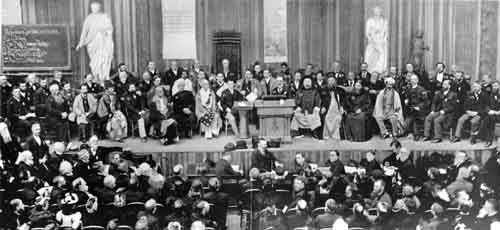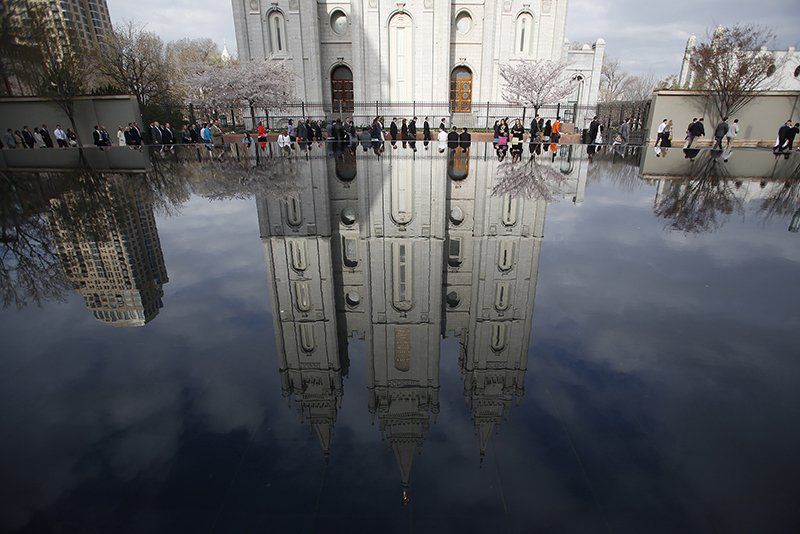
Chicago Parliament of world’s religions in September 1893.
SALT LAKE CITY (RNS) When the World’s Parliament of Religions first met in Chicago in 1893, Christians, Jews, Hindus, Buddhists, Muslims and even Spiritualists prayed together.
But Mormons were kept out.
What a difference 122 years make. On Thursday (Oct. 15), when the Parliament of the World’s Religions — a slight adjustment of the name was made a century after the first meeting — convenes in Salt Lake City, it will not only feature a slate of Mormon voices, it will sit in the proverbial lap of the Church of Jesus Christ of Latter-day Saints, its global headquarters only a five-minute walk away.
The selection of this city is no coincidence, organizers and participants say, but a clear sign that both the LDS church and the parliament have evolved.
READ: Meet the Nobel-nominated priest who rescues African refugees from Mediterranean
“It speaks to the fact that the Church of Jesus Christ of Latter-day Saints is a world religion and we are being recognized as such on the world stage,” said Rachel Mabey Whipple, a Mormon environmentalist who will speak about Mormonism and sustainability at the event. “It shows a confidence that we are able to bring these other faith leaders to our community, and that is a great amount of maturity that I don’t know that we have always had.”
The parliament, which closes Monday, is expected to attract between 8,000 and 10,000 participants from 80 countries and 50 spiritual or faith traditions. This is the first time the parliament has met on U.S. soil since 1993, when it was held in Chicago. Recent meetings have been in Spain, Australia and South Africa.

People walk past Salt Lake temple as they arrive to attend the biannual general conference of the Church of Jesus Christ of Latter-day Saints in Salt Lake City on April 5, 2014. Photo courtesy of REUTERS/Jim Urquhart
*Note: This photo may only be republished with RNS-MORMON-GAYS, originally published on Jan. 27, 2015, or RNS-TRANS-MORMONS, originally published on April 1, 2015, or with RNS-PARLIAMENT-RELIGIONS, originally transmitted on Oct. 14, 2015.
Other voices shut out of the first parliament will be in Salt Lake City, too. No Native American faiths were included at the 19th-century gathering, but now they make up a significant slice of speakers and participants, and some have set up tepees and other native dwellings outside the Salt Palace convention site. Leaders of Native American and other indigenous faiths will tackle topics as wide-ranging as teen suicide and the wisdom of grandmothers.
“It’s about time they begin to listen to” Native Americans and indigenous peoples, said Arnold Thomas, a Shoshone-Paiute tribal member who will speak. “We have not always been considered human beings” by some of the faiths represented at the parliament in the past, he added.
READ: Catholic bishops at Vatican summit seek elusive common ground
Atheists will have a presence, too, in a session with religious leaders on human suffering. David Silverman, president of American Atheists — which held its annual convention in Salt Lake City earlier this year — said including nonbelievers makes the parliament truly interfaith.
“When the entire community is represented, people can truly unite with all their neighbors toward a common goal, without any outsiders at all,” Silverman said in an email interview. “Everyone is equal, regardless of religious belief.”
Everyone may be equal, but not everyone is counted among the attendees. Catholic, Orthodox, evangelical and Pentecostal Christians do not attend in any strength or send official representatives, with the bulk of Christians coming from mainline Protestant denominations. Most Eastern faiths send representatives, and the Dalai Lama was scheduled to speak until ill health forced him to cancel.
What inclusivity there is has been neither swift nor smooth. The first parliament, held in the wake of the tremendously popular World’s Columbian Exposition, was groundbreaking for its inclusion of Eastern religions. Buddhism, Hinduism and the Baha’i faith were introduced to Americans from the parliament’s stage, set in what is now the Art Institute of Chicago.
But Mormons were mostly shunned. A lone Mormon woman was allowed to address a smaller auxiliary meeting of women at the event.
READ: A year after ‘Peeping Tom’ rabbi’s arrest, his congregation perseveres
The problem was polygamy. The LDS church banned plural marriage in 1890, but many Mormons still practiced it. Today only splinter Mormons not associated with the church embrace polygamy.
And therein lies a huge irony, says Andrea Radke-Moss, a Mormon historian and feminist also among this week’s speakers. In 1893, Mormons were excluded because their ideas of marriage and family were too radical. But Mormon Elder L. Whitney Clayton, the highest-ranking church official at this year’s parliament and one of its featured speakers, will likely address the the church’s support of traditional marriage and sexuality.
Radke-Moss commended the parliament’s embrace of Mormons and other once-excluded faith traditions. But she laments what she sees as a scarcity of female Mormon voices — even though this year’s meeting will specially focus on women in religious traditions, with an entire day given over to a Women’s Assembly. While one smaller session will examine Mormon feminism, only author Terry Tempest Williams is among the parliament’s main speakers, and she is expected to focus on environmentalism, not her Mormon faith, of which she has been an outspoken critic. Her religious affiliation is not mentioned in her parliament biography.
“Mormon women are still not completely invited to the table, even in Salt Lake City,” Radke-Moss said.
Video courtesy of Parliament of the World’s Religions via YouTube
YS/MG END WINSTON




